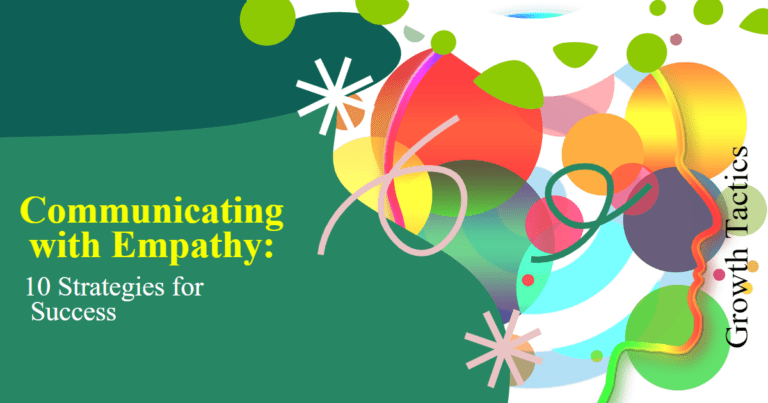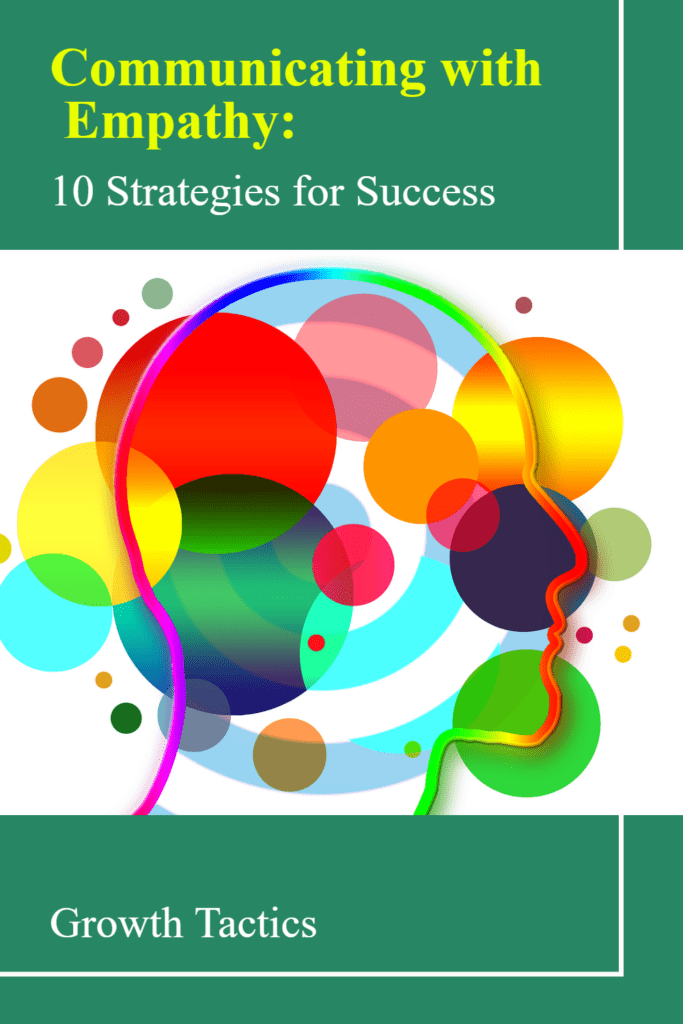Effective communication is one of the keys to success in both our professional and personal lives. A big part of communication is understanding the perspectives of others, being able to empathize with them, and acknowledging their feelings.
This is where empathy comes in. Empathy is an essential element of successful communication because it helps us communicate in a way that is sensitive, positive, and collaborative. In this post, we will explore strategies for communicating with empathy and how to overcome the barriers that prevent us from using empathy in our relationships.
Jump To Section
What is Empathy?
Empathy is the ability to understand and share the feelings of others. It is an essential component of emotional intelligence and helps us build strong relationships with others. There are different levels of empathy, including emotional empathy, which is the ability to understand and feel the emotions of others, and cognitive empathy, which is the ability to understand the perspectives and thoughts of others without necessarily sharing their emotions.
Why is Empathy Important?
Empathy is important for effective communication because it helps us connect with others at a deeper level. It allows us to understand the feelings and perspectives of others, even when we disagree with them. When we communicate with empathy, others feel heard, valued, and understood. This creates a positive and collaborative environment, which is essential for building strong relationships with coworkers, resolving conflicts, and achieving shared goals.
Barriers to Empathic Communication
Even though empathy is an important aspect of effective communication, there are several barriers that can hinder our ability to use empathy effectively. Understanding these barriers is crucial in order to overcome them and communicate more empathetically. Let’s explore some of the common barriers:
1. Communication Style
One of the most significant barriers to empathic communication is our own communication style. While some individuals naturally possess empathetic communication skills, others may struggle to express empathy in a genuine and authentic way. These differences in communication styles can be influenced by various factors such as upbringing, personality traits, and cultural background. For example, individuals who have been raised in environments where empathy was highly valued and encouraged may find it easier to empathize with others. On the contrary, those who have not had much exposure to empathetic communication may find it more challenging to express empathy effectively.
2. Work Environment
The demands and pressure of the work environment can also act as a barrier to empathic communication. With the constant need to meet deadlines, respond to emails, and attend numerous meetings, finding the time to communicate empathetically can be a challenge. The fast-paced nature of work can make it difficult to slow down and truly listen to others. This can result in superficial interactions and a lack of genuine connection. It is essential to create a work culture that encourages and values empathic communication, even in the midst of a busy environment.
3. Fear of Vulnerability
Another barrier to empathic communication is the fear of being vulnerable. Opening oneself up and displaying empathy requires a level of emotional vulnerability. This vulnerability can be intimidating for some individuals, as it exposes them to the risk of rejection or judgment. Consequently, they may choose to withhold their empathetic responses and rely on more detached and impersonal communication styles. Overcoming this fear of vulnerability is necessary to create a safe space where genuine connections can thrive.
4. Cognitive Biases
Cognitive biases are another obstacle to empathic communication. These biases are inherent mental shortcuts that our brains use to process information quickly. However, these shortcuts can lead to inaccurate assumptions and misinterpretations of others’ emotions and perspectives. For instance, confirmation bias, which is the tendency to interpret information in a way that confirms our preexisting beliefs, can hinder our ability to empathize with differing viewpoints. Overcoming cognitive biases requires conscious effort and a willingness to question our assumptions and biases.
5. Negative Stereotypes
Negative stereotypes can also impede empathic communication. Stereotypes are generalizations and assumptions that individuals have about certain groups of people. When we rely on these stereotypes, we tend to overlook the uniqueness and individuality of each person. This can hinder our ability to empathize with others and see beyond the surface level. Overcoming negative stereotypes requires open-mindedness, a willingness to challenge assumptions, and a commitment to recognizing the individuality of each person.
In order to become better empathic communicators, it is crucial to acknowledge and overcome these barriers. By developing a deeper understanding of our own communication style, creating a supportive work environment, embracing vulnerability, challenging cognitive biases, and dispelling negative stereotypes, we can enhance our empathic communication skills. By doing so, we can foster stronger connections, build trust, and create a more inclusive and collaborative environment for effective communication to thrive.
Empathy in the Workplace
Empathic communication is especially important in the workplace. It allows for better collaboration and understanding among employees, which can lead to higher productivity, job satisfaction, and employee retention. In addition, empathic communication skills are important for leaders, who need to be able to understand the perspectives of their team members and communicate with them in a way that is positive, respectful, and motivating.
Strategies for Communicating with Empathy
Empathy is not just a personality trait, but it is also a skill that can be cultivated and developed. Here are some practical strategies for communicating with empathy:
1. Practice Self-Awareness
The first step in cultivating empathy is developing self-awareness. We need to understand our own communication style and be aware of our own biases, assumptions, and emotional reactions. Self-awareness can be developed by observing our own thought processes, reflecting on our actions and reactions, or seeking feedback from others. By being more aware of ourselves, we can better understand how our words and actions can impact others.
2. Listen to Understand
Another essential aspect of empathic communication is active listening. This means listening with the intention of understanding rather than listening to respond. Active listening requires giving our full attention to the speaker, validating their emotions and feelings, and asking clarifying questions. By genuinely listening to others, we show that we respect and value their perspective.
3. Communicate Empathetically
Effective communication involves not only listening but also expressing empathy. We need to acknowledge the feelings and perspectives of others, even if we don’t agree with them. Empathetic communication involves showing that we understand and respect the other person’s viewpoint. Simple yet powerful phrases such as “I can see how you feel and why that would be hard for you,” or “I’m sorry you had to go through that” can help to convey empathy.
4. Try to Understand the Other Person’s Point of View
Empathetic communication requires us to put ourselves in the other person’s shoes and understand their perspective. This involves paying attention to their nonverbal cues, listening to their story, and asking open-ended questions to get clarity or more information. When we understand the other person’s point of view, we can communicate more effectively and develop a deeper connection.
5. Use Nonverbal Cues
Nonverbal communication can also play a significant role in communicating empathetically. Using appropriate nonverbal cues, such as nodding, smiling, making eye contact, and having an open body posture, can convey that we are actively listening and are present in the conversation. These actions can help others feel heard, understood, and validated.
6. Practice Empathy Outside of Work
Finally, practicing empathy outside of work can help cultivate empathy as a skill. We can try to understand the perspectives of our friends, family members, and community members. We can also practice looking at situations from different angles and brainstorming possible solutions from various perspectives. By routinely practicing empathy, we can develop the skill of communicating with empathy and build stronger relationships with others.
7. Show Empathy Through Empathic Statements
In addition to actively listening, using empathic statements can further demonstrate our understanding and empathy. Repeat or paraphrase the speaker’s thoughts or emotions to show that we are truly engaged and trying to understand. Phrases like “It sounds like you’re feeling…” or “I can imagine that this situation is…” can validate the speaker’s experiences and emotions.
8. Practice Empathy Daily
Empathy is a skill that can be enhanced with practice. Look for opportunities to show empathy in your daily interactions, both in personal and professional settings. Take the time to connect with others, listen to their stories, and try to understand their perspectives. The more you actively practice empathy, the more it will become a natural part of your communication style.
9. Practice Emotional Regulation
When engaging in empathetic communication, it’s important to regulate our own emotions. Becoming aware of our emotional state and learning to manage it can help us respond in a more empathetic manner. Taking deep breaths, engaging in self-soothing techniques, or taking a pause before responding can prevent our own emotions from clouding our ability to understand and empathize with others.
10. Avoid Judging or Criticizing
Empathetic communication requires suspending judgment and avoiding criticism. Instead of immediately reacting or providing unsolicited advice, try to understand the underlying emotions and experiences of the other person. Offering support and validation without passing judgment creates a safe and empathetic space for open dialogue.
In conclusion, empathy is an essential element of effective communication, especially in the workplace. It allows us to understand the perspectives and feelings of others, which is essential for building strong relationships and achieving shared goals. By cultivating empathy and using it in our communication, we can create a positive and collaborative work environment where everyone feels valued, heard and understood.


